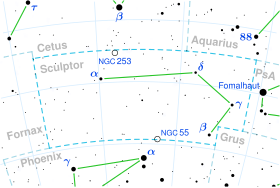Gamma Sculptoris
| Observation data Epoch J2000 Equinox J2000 | |
|---|---|
| Constellation | Sculptor |
| Right ascension | 23h 18m 49.44076s[1] |
| Declination | −32° 31′ 55.2890″[1] |
| Apparent magnitude (V) | 4.41[2] |
| Characteristics | |
| Spectral type | K1 III[3] |
| U−B color index | +1.06[4] |
| B−V color index | +1.13[4] |
| Astrometry | |
| Radial velocity (Rv) | +15.60[5] km/s |
| Proper motion (μ) | RA: +20.13[1] mas/yr Dec.: −77.72[1] mas/yr |
| Parallax (π) | 17.90 ± 0.19 mas[1] |
| Distance | 182 ± 2 ly (55.9 ± 0.6 pc) |
| Absolute magnitude (MV) | 0.67[2] |
| Details | |
| Mass | 1.60[6] M☉ |
| Radius | 12[7] R☉ |
| Luminosity | 72.41[2] L☉ |
| Surface gravity (log g) | 2.45[6] cgs |
| Temperature | 4,578±24[8] K |
| Metallicity [Fe/H] | −0.06[6] dex |
| Rotational velocity (v sin i) | 1.7[9] km/s |
| Age | 2.47[8] Gyr |
| Other designations | |
| Database references | |
| SIMBAD | data |
Gamma Sculptoris, Latinized from γ Sculptoris, is a single,[11] orange-hued star in the constellation Sculptor. Based upon an annual parallax shift of 17.90 mas as seen from Earth,[1] this star is located about 182 light years from the Sun. It is bright enough to be visible to the naked eye with an apparent visual magnitude of 4.41.[2] It is moving away from the Sun with a radial velocity of +15.6 km/s.[5]
This is an evolved K-type giant star with a stellar classification of K1 III.[3] At the age of 2.47[8] billion years it is a red clump star on the horizontal branch,[6] which means it is generating energy through helium fusion at its core. The star has 1.60[6] times the mass of the Sun and it has expanded to 12[7] times the Sun's radius. It is radiating 72[2] times the Sun's luminosity from its enlarged photosphere at an effective temperature of 4,578 K[8]
References[edit]
- ^ a b c d e f Van Leeuwen, F. (2007). "Validation of the new Hipparcos reduction". Astronomy and Astrophysics. 474 (2): 653–664. arXiv:0708.1752. Bibcode:2007A&A...474..653V. doi:10.1051/0004-6361:20078357. S2CID 18759600. Vizier catalog entry
- ^ a b c d e Anderson, E.; Francis, Ch. (2012). "XHIP: An extended hipparcos compilation". Astronomy Letters. 38 (5): 331. arXiv:1108.4971. Bibcode:2012AstL...38..331A. doi:10.1134/S1063773712050015. S2CID 119257644. Vizier catalog entry
- ^ a b Hoffleit, D.; Warren, W. H. (1995). "VizieR Online Data Catalog: Bright Star Catalogue, 5th Revised Ed. (Hoffleit+, 1991)". VizieR On-line Data Catalog: V/50. Originally Published in: 1964BS....C......0H. 5050. Bibcode:1995yCat.5050....0H.
- ^ a b Mallama, A. (2014). "Sloan Magnitudes for the Brightest Stars". The Journal of the American Association of Variable Star Observers. 42 (2): 443. Bibcode:2014JAVSO..42..443M.Vizier catalog entry
- ^ a b Wilson, R. E. (1953). "General Catalogue of Stellar Radial Velocities". Carnegie Institute Washington D.C. Publication. Carnegie Institution for Science. Bibcode:1953GCRV..C......0W. ISBN 9780598216885. LCCN 54001336.
- ^ a b c d e Liu, Y. J.; Zhao, G.; Shi, J. R.; Pietrzynski, G.; Gieren, W. (2007). "The abundances of nearby red clump giants". Monthly Notices of the Royal Astronomical Society. 382 (2): 553. Bibcode:2007MNRAS.382..553L. doi:10.1111/j.1365-2966.2007.11852.x.
- ^ a b Allende Prieto, C.; Lambert, D. L. (1999). "Fundamental parameters of nearby stars from the comparison with evolutionary calculations: Masses, radii and effective temperatures". Astronomy and Astrophysics. 352: 555–562. arXiv:astro-ph/9911002. Bibcode:1999A&A...352..555A. Vizier catalog entry
- ^ a b c d Luck, R. Earle (2015). "Abundances in the Local Region. I. G and K Giants". Astronomical Journal. 150 (3). 88. arXiv:1507.01466. Bibcode:2015AJ....150...88L. doi:10.1088/0004-6256/150/3/88. S2CID 118505114.Vizier catalog entry
- ^ De Medeiros, J. R.; Alves, S.; Udry, S.; Andersen, J.; Nordström, B.; Mayor, M. (2014). "A catalog of rotational and radial velocities for evolved stars". Astronomy & Astrophysics. 561: A126. arXiv:1312.3474. Bibcode:2014A&A...561A.126D. doi:10.1051/0004-6361/201220762. S2CID 54046583. Vizier catalog entry
- ^ "gam Scl". SIMBAD. Centre de données astronomiques de Strasbourg. Retrieved 2017-12-03.
- ^ Eggleton, P. P.; Tokovinin, A. A. (September 2008). "A catalogue of multiplicity among bright stellar systems". Monthly Notices of the Royal Astronomical Society. 389 (2): 869–879. arXiv:0806.2878. Bibcode:2008MNRAS.389..869E. doi:10.1111/j.1365-2966.2008.13596.x. S2CID 14878976.

